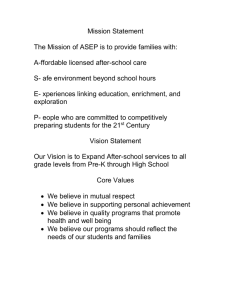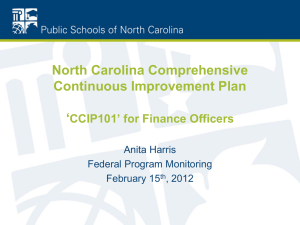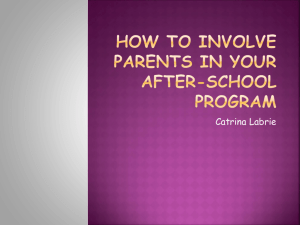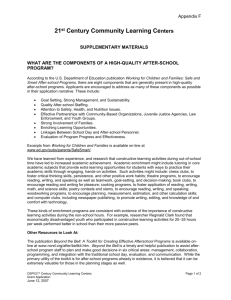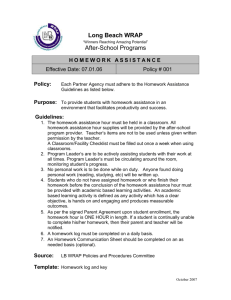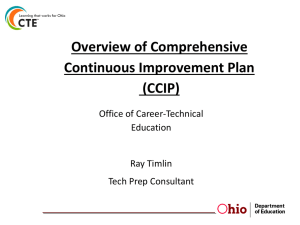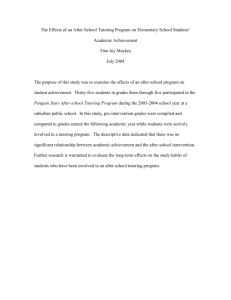After-School Quality Improvement Grant Program NORTH CAROLINA October 22, 2014
advertisement
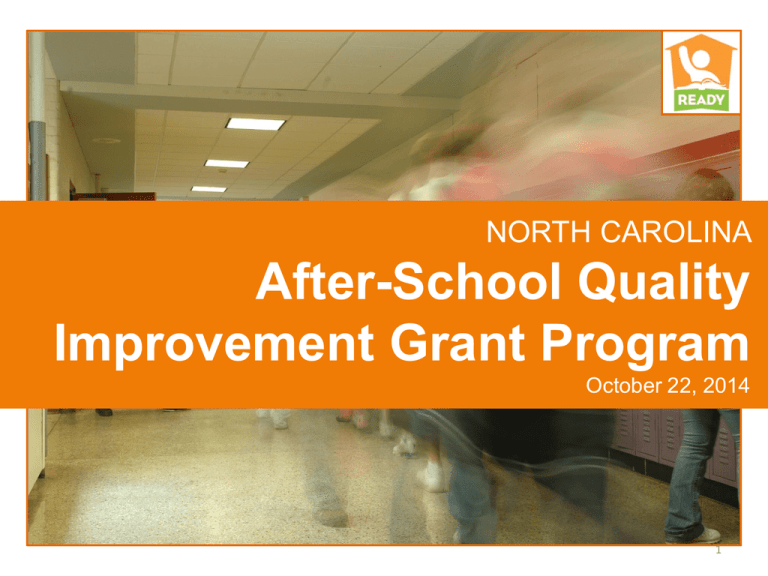
NORTH CAROLINA After-School Quality Improvement Grant Program October 22, 2014 1 Housekeeping Due to the large number of participants, please use the question box feature during the webinar to submit any questions. Any questions not answered during the webinar will be collected and used to update the FAQs. The presentation slides will be posted on the website at: http://www.ncpublicschools.org/programmonitoring/after-school/. 2 High-Quality After-School Programs Improved test scores and school grades Improved school attendance and engagement Lower dropout rates Reduced juvenile crime Increased awareness of healthy lifestyles Reduced summer learning loss 3 The North Carolina Program • North Carolina General Assembly appropriated five million dollars ($5,000,000) in state funds for the After-School Quality Improvement Grant Program (Program) • Provides funds to pilot after-school learning programs for at-risk students that raise student academic outcomes • Offers up to five hundred thousand dollars ($500,000) a year for two years with an option for a third year of funding 4 Focus of the Program • Evidence-based model with a proven track record of success • Rigorous quantitative performance measures • Alignment with NC Standard Course of Study • Prioritization for STEM and reading • Emphasis on minimizing staff/student ratios • Expansion of student access to learning activities and academic support that strengthen student engagement and leverage communitybased resources 5 Requirements • Eligible recipients include local education agencies (LEAs) and nonprofits working in collaboration with LEAs • Funds available on a 3 to 1 match (i.e., matching donations and in-kind contributions) • Match cannot include state funds or federal funds with supplement/supplant provisions • At least 70% of students served must be eligible for free or reduced-price meals 6 Tentative Timeline • October 1 – Request for Proposals (RFP) approved by State Board of Education (SBE) • October 17 – Intent to Apply due • October 22 – Technical Assistance Webinar • November 14 – Application due by 11:59 p.m. EST • January 2 – Recommendations to the SBE for approval 7 Request for Proposals Involvement of staff across DPI divisions o o o o o o Federal Programs Curriculum and Instruction K-3 Literacy Career and Technical Education Financial and Business Services Accountability 8 Intent to Apply Used to determine the number of reviewers needed for the application review process • Not a prerequisite for application of grant funds • Does not obligate the organization to submit an application 9 How to Apply 1. Develop proposals utilizing tools as needed • • • • Application Guidance (with Rating Rubric) Application Planning Worksheets Frequently Asked Questions Cost Calculator/NC Department of Commerce Tiers 2. Prepare to submit application through the web-based grants management system, the Comprehensive Continuous Improvement Plan (CCIP) 10 Using the Cost Calculator • Calculator estimates should be viewed as good general cost estimates • Cost Calculator will provide an annual total program cost with low, median, and high estimations • The total request for each organization must be based on the NC Department of Commerce’s 2014 Tier Designations • Organizations may request up to 75% of the total cost to account for the required match • No application will receive an award totaling more than $500,000 11 Tier 1 Tier 2 Tier 3 • High estimate • 75% of total • Median estimate • 75% of total • Low estimate • 75% of total 12 Using CCIP • LEAs must determine the local User Account Administrator • All LEAs have staff trained on CCIP • Contact Title I office if needed • Nonprofits must acquire a valid NCID to access CCIP • CCIP training offered October 23-24 and October 26-27 • CCIP training materials posted on website • May have the collaborating LEA submit the application in CCIP 13 Application Components Planning Tool Funding Application • Needs Assessment • Goals • Budget • Grant Details • Plan Relationships • Related Documents 14 Proposal Evaluations • Only complete applications submitted through the CCIP system marked as “Draft Completed” by the deadline will be reviewed • Each application will be reviewed by 3 independent evaluators • Evaluators use the Application Rating Rubric (Appendix F in Application Guidance) • Scores are averaged to determine final score • Priorities for STEM and reading activities are embedded within the Rating Rubric 15 Proposal Evaluations EXAMPLE: Needs Assessment The applicant provides a description of the needs assessment conducted to determine the proposed program. • STEM Priority: applicant completes the STEM Attribute Selfassessment Summary Rubric and provides narrative evidence of level of achievement and explicit justification of need. • Language Priority: applicant provides evidence of reading results for levels of students being served (K-3 mClass benchmark data comparisons BOY-EOY, Grades 4-8 EOG reading results, 6-12 EOC results) along with a detailed summary of data analysis and trends. 16 Frequently Asked Questions Frequently Asked Questions are posted at: http://www.ncpublicschools.or g/program-monitoring/afterschool/ 17 Frequently Asked Questions Which organizations are eligible to apply for the grants? The law states, “Local school administrative units and nonprofits working in collaboration with local school administrative units may participate in the program.” 18 Frequently Asked Questions Are charter schools considered to be “local school administrative units?” No. In accordance with Public School Law, “‘Local school administrative unit’ means a subdivision of the public school system which is governed by a local board of education. It may be a city school administrative unit, a county school administrative unit, or a city-county school administrative unit.” [§ 115C-5.] A charter school is a public school operated by a private nonprofit corporation and as such, is considered to be a nonprofit for the purpose of applying for these grants. [§ 115C238.29E.] Additionally, other nonprofits working in collaboration with local school administrative units may apply for the funds. 19 Frequently Asked Questions Can the entire grant be operated through a school within an LEA with the school serving as the fiscal agent? The local education agency (LEA) must apply on behalf of one or more of its schools and serve as the Fiscal Agent. 20 Frequently Asked Questions Since the budget for community groups will be run through the LEA , will the proposal for community groups be entered into the district’s CCIP or the nonprofit’s own CCIP? If a nonprofit working in collaboration with a local school administrative unit (i.e., LEA) wishes to apply directly through CCIP, the organization may do so. However, it is strongly recommended that nonprofit applicants collaborate with LEAs to submit the funding application through the CCIP system. While this is not required and will not impact the selection process for any application submitted by the due date, it may reduce burden for nonprofit applicants as it relates to training necessary for using the CCIP system (i.e., all LEAs already have local staff trained on the use of CCIP). 21 Frequently Asked Questions In the Purpose section of the Application Guidance document, it states that, “the purpose …. is to pilot after-school learning programs.” Does this mean that the program is designed to support new programs and not supplement existing programs? Yes. However, this does not prevent organizations that offer other afterschool programs from using those same program designs in conjunction with the state-funded After-School Quality Improvement Grant Program to serve schools/students not currently served. For example, an applicant may use the After-School Quality Improvement Grant Program to serve K-2 students using the same program design as the applicant’s existing program that currently serves students in grades 35. Any program funded through the After-School Quality Improvement Grant Program will be considered as a standalone program for the purposes of meeting legislated requirements. (Updated 11/03/2014) 22 Frequently Asked Questions Since LEAs will serve as fiscal agents for nonprofit groups that apply for these funds, how will funds be managed? In order to comply with financial reporting and cash management procedures established through the state’s Uniform Education Reporting System (UERS), each nonprofit applicant, including public charter schools, must identify the local school administrative unit that will serve as the Fiscal Agent for the grant. LEAs will manage the funds through their standard fiscal procedures. 23 Frequently Asked Questions Can a nonprofit partner with multiple LEAs for one application? If yes, who serves as the Fiscal Agent? If multiple LEAs are partnering with a single nonprofit applicant, then one LEA must be identified as the Fiscal Agent for the grant. 24 Frequently Asked Questions Are these funds provided through a federal or state funding source (Fund 1 or Fund 3)? The funds provided for the After-School Quality Improvement Grant Program are state funds provided by the General Assembly through Session Law 2014-100. 25 Frequently Asked Questions Will this Program Report Code (PRC) be linked to the Department’s budgeting system in the same way as other federal funds so that budgeting is accomplished through the Department’s budgeting system? The PRC for the After-School Quality Improvement Grant Program is PRC 040 and the funds will be managed through the Department’s budgeting system. 26 Frequently Asked Questions What is the period of availability for the AfterSchool Quality Improvement Grant Program funds? The grant cycle is aligned to the state fiscal year. The funding that is approved by the State Board of Education will be available for the second year of the program contingent upon legislative budget approval and the applicant organization’s compliance with reporting requirements. 27 Frequently Asked Questions Do funds carry over from year one to year two? Yes. 28 Frequently Asked Questions Since the funds are not available until January, how many weeks of programming should be input into the Wallace Foundation Cost Calculator? The number of weeks entered into the Cost Calculator should be for a full year of programming. Typically there are more program costs for the first year of implementation when operating a multi-year grant supported after-school program. Additionally, remaining carryover funds may be used to support or expand the program in the second year of implementation. 29 Frequently Asked Questions Can the After-School Quality Improvement Grant Program be offered during the summer? Yes. Summer programming or programs that operate during intercessions are generally accepted as after-school programs (i.e., time outside of the regular school day). 30 Frequently Asked Questions May applicants use the value of classrooms and campus space as match? Yes. In-kind contributions may include any non-monetary resources that partners and the sub-grantee’s organization provide to support the project based on fair market value which may include the use of “space” for the program. In general, the match requirement may be met through any donated funds or in-kind contributions which are not funded through state or federal supplemental funds (e.g., 21st Century Community Learning Center grants). 31 Frequently Asked Questions May vendor discounts count toward meeting the match requirement? Yes. The value of the discount may be attributed to the match requirement. In general, the match requirement may be met through any donated funds or in-kind contributions which are not funded through state or federal supplemental funds. 32 Frequently Asked Questions Appendix D states that “only students with a signed and completed Form on file will be considered for these need-based opportunities.” Appendix D does not contain an option stating that none of the income choices are applicable (student does not qualify for F/R). Do the parents of all participants have to submit a form? No. Using the form does not prohibit the program from allowing 30% of the participants to be children whose families have not sent back the needs-based survey. 33 Frequently Asked Questions May the organization use household applications or direct certification data collected for the Community Eligibility Provision instead of the needs-based survey? No. Given student privacy issues around family income status, School Nutrition Services provided the form as an alternative to determining a student’s eligibility (i.e., instead of data collected through household applications or direct certification). 34 Frequently Asked Questions When will CCIP be updated to include the AfterSchool Quality Improvement Grant Program? The Department intends to have the new grants included in CCIP by the end of October. Using the Application Planning Worksheets will ensure that organizations have sufficient time to develop plans prior to entering information into the grants management system. 35 RESOURCES • • • • • • 2014 North Carolina County Tier Designations http://www.nccommerce.com/research-publications/incentivereports/county-tier-designations Afterschool Alliance http://www.afterschoolalliance.org/publications.cfm After-School Quality Improvement Grant Program http://www.ncpublicschools.org/program-monitoring/afterschool/ North Carolina Center for Afterschool Programs (NC CAP) http://www.nccap.net/ Southwest Educational Development Laboratory http://www.sedl.org/expertise/afterschool.html Wallace Foundation http://www.wallacefoundation.org/knowledge-center/afterschool/key-research/Documents/The-Cost-of-Quality-of-Out-ofSchool-Time-Programs.pdf. 36 Thank You! 37
